A Common Approach to Geo-Referencing Building Models in Industry Foundation Classes for BIM/GIS Integration
Abstract
:1. Introduction
2. Literature Review: Geo-Referencing
2.1. Interpretations of ‘Geo-Referencing’
2.2. Geo-Referencing: Establishing Spatial Reference or Coordinate Transformation
2.3. Geo-Referencing Capability of IFCs
3. Establishment of the Common Geo-Referencing Approach for IFCs
3.1. Key IFC Entities in Geo-Referencing IFC (Geo-Referencing Elements)
3.1.1. The Placement Hierarchy in IFCs
3.1.2. Geographic Reference Point in IfcSite and IfcGeometricRepresentationContext in IfcProject
3.2. Combining IFC Placement Hierarchy and Geo-Referencing Elements
3.3. The Common Geo-Referencing Approach
3.3.1. Obtaining Transformation Parameters
3.3.2. Coordinate Transformation
4. Experiments, Results and Analysis
4.1. Data
4.2. Implementation
4.3. Comparison with FME
5. Discussion
- (1)
- Meaning of geo-referencing in BIM/GIS integration
- (2)
- A full geo-referencing model
- (3)
- A common geo-referencing approach
- (4)
- Levels of spatial reference
6. Conclusions
- (1)
- The meaning of geo-referencing has been clarified for BIM/GIS data integration. Geo-referencing in the context of BIM/GIS integration refers to the process of establishing spatial reference for BIM models so that they can be managed and analyzed in a GIS after their local coordinate system is transformed into a proper coordinate reference system. Its focus is to establish a spatial reference with a CRS for BIM models, given that the CRS has been properly selected. As for the distortion of the CRS, it is considered as acceptable and beyond the scope of geo-referencing in the context of BIM/GIS integration.
- (2)
- A common geo-referencing approach that can be applied to both officially valid IFC versions, or even future IFC versions, was developed by a systematic and thorough investigation into IFC standards and combining the common geo-referencing elements with the placement hierarchy of IFC. This study proves that the early version of the IFC is already sufficient for accurate geo-referencing. In addition, this study uses all IFC entities in their original way without the need of modification or extension to existing IFC standards.
- (3)
- A level of spatial reference (LoSR) concept was conceptualized. BIM models at LoSR1 should embed information regarding the geographic reference point and true north, while models at LoSR2 should define IfcMapConversion. It is suggested that BIM models should be at least in LoSR1 in order to be accurately geo-referenced.
Author Contributions
Funding
Data Availability Statement
Acknowledgments
Conflicts of Interest
Appendix A. Python Codes for Retrieving Geographic Reference Point, True North and Conversion of Geodetic Coordinates to Map Coordinates
| # retrieve true north and turn it into transformation matrix def getTransformMatrix(project): def getModelContext(project): flag = False for context in project.RepresentationContexts: if context.ContextType == ‘Model’: flag = True return context if flag == False: print ‘No context for model was found in this project’ contextForModel = getModelContext(project) a,b = contextForModel.TrueNorth.DirectionRatios transformMatrix = [[b, -a, 0], [a, b, 0], [0, 0, 1]] transformMatrix = np.mat(transformMatrix).I return transformMatrix #retrieve geographic reference point and transform the geodetic coordinates into map coordinates def getOriginShift(site): def mergeDegrees(Degrees): if len(Degrees) == 4: degree = Degrees[0]+Degrees[1]/60.0+(Degrees[2]+Degrees[3]/1000000.0)/3600.0 elif len(Degrees) == 3: degree = Degrees[0]+Degrees[1]/60.0+Degrees[2]/3600.0 else: print ‘Wrong input of degrees’ return degree Lat,Lon = site.RefLatitude, site.RefLongitude a, b = mergeDegrees(Lat), mergeDegrees(Lon) crs = pyproj.CRS.from_epsg(32632) proj = pyproj.Transformer.from_crs(4326,crs) a, b = proj.transform(a,b) c = site.RefElevation return [a,b,c] |
Appendix B. Python Codes for Implementing Geo-Referencing
| def georeferencing(inFeature, transMatrix, originShift, outFeature): sf_multipatch = shapefile.Reader(inFeature) attList = [sf_multipatch.fields[i][0] for i in range(1,len(sf_multipatch.fields))] shpWriter = initiateShpWriter(attList) shapes = sf_multipatch.shapes() records = sf_multipatch.records() for i in range(len(shapes)): shape = shapes[i] #each shape is a multipatch, and can contains many faces (parts) record = records[i] points = np.hstack((np.mat(shape.points),np.mat(shape.z).T)) points = points.tolist() parts = [] for k in range(len(shape.parts)): if k! = len(shape.parts)-1: ring = points[shape.parts[k]:shape.parts[k+1]] else: ring = points[shape.parts[k]:] result = np.mat(ring)*np.mat(transMatrix)+np.mat(origin_shift) result = np.round(result,9).tolist() parts.append(result) partTypes = (np.ones(len(parts))*5).tolist() shpWriter.poly(parts = parts, partTypes = partTypes, shapeType = 31) shpWriter.records.append(record) shpWriter.save(outFeature) |
References
- Longley, P.A.; Goodchild, M.F.; Maguire, D.J.; Rhind, D.W. Geographic Information Science and Systems; John Wiley & Sons: Hoboken, NJ, USA, 2015. [Google Scholar]
- Cressie, N. Statistics for Spatial Data; John Wiley & Sons: Hoboken, NJ, USA, 2015. [Google Scholar]
- Hackeloeer, A.; Klasing, K.; Krisp, J.M.; Meng, L. Georeferencing: A review of methods and applications. Ann. GIS 2014, 20, 61–69. [Google Scholar] [CrossRef]
- Zhu, J.; Wright, G.; Wang, J.; Wang, X. A Critical Review on the Integration of Geographic Information System and Building Information Modelling at the Data Level. ISPRS Int. J. Geo-Inf. 2018, 7, 66. [Google Scholar] [CrossRef] [Green Version]
- ESRI. Fundamentals of Georeferencing a Raster Dataset. Available online: https://desktop.arcgis.com/en/arcmap/latest/manage-data/raster-and-images/fundamentals-for-georeferencing-a-raster-dataset.htm (accessed on 27 January 2021).
- Donkers, S.; Ledoux, H.; Zhao, J.; Stoter, J. Automatic conversion of IFC datasets to geometrically and semantically correct CityGML LOD3 buildings. Trans. GIS 2016, 20, 547–569. [Google Scholar] [CrossRef] [Green Version]
- Zhu, J.; Wu, P.; Chen, M.; Kim, M.J.; Wang, X.; Fang, T. Automatically processing IFC clipping representation for BIM and GIS integration at the process level. Appl. Sci. 2020, 10, 2009. [Google Scholar] [CrossRef] [Green Version]
- Zhu, J.; Wu, P. Towards Effective BIM/GIS Data Integration for Smart City by Integrating Computer Graphics Technique. Remote Sens. 2021, 13, 1889. [Google Scholar] [CrossRef]
- Wang, H.; Pan, Y.; Luo, X. Integration of BIM and GIS in sustainable built environment: A review and bibliometric analysis. Autom. Constr. 2019, 103, 41–52. [Google Scholar] [CrossRef]
- Colucci, E.; De Ruvo, V.; Lingua, A.; Matrone, F.; Rizzo, G. HBIM-GIS integration: From IFC to cityGML standard for damaged cultural heritage in a multiscale 3D GIS. Appl. Sci. 2020, 10, 1356. [Google Scholar] [CrossRef] [Green Version]
- Diakite, A.A.; Zlatanova, S. Automatic geo-referencing of BIM in GIS environments using building footprints. Comput. Environ. Urban Syst. 2020, 80, 101453. [Google Scholar] [CrossRef]
- Clemen, C.; Hendrik, G. Level of Georeferencing (LoGeoRef) using IFC for BIM. J. Geod. 2019, 10, 15–20. Available online: https://jgcc.geoprevi.ro/docs/2019/10/jgcc_2019_no10_3.pdf (accessed on 3 March 2021).
- Zhu, J.; Tan, Y.; Wang, X.; Wu, P. BIM/GIS integration for web GIS-based bridge management. Ann. GIS 2020, 27, 99–109. [Google Scholar] [CrossRef] [Green Version]
- Tan, Y.; Song, Y.; Zhu, J.; Long, Q.; Wang, X.; Cheng, J.C. Optimizing lift operations and vessel transport schedules for disassembly of multiple offshore platforms using BIM and GIS. Autom. Constr. 2018, 94, 328–339. [Google Scholar] [CrossRef]
- Teo, T.-A.; Cho, K.-H. BIM-oriented indoor network model for indoor and outdoor combined route planning. Adv. Eng. Inform. 2016, 30, 268–282. [Google Scholar] [CrossRef]
- Isikdag, U.; Underwood, J.; Aouad, G. An investigation into the applicability of building information models in geospatial environment in support of site selection and fire response management processes. Adv. Eng. Inform. 2008, 22, 504–519. [Google Scholar] [CrossRef]
- Isikdag, U. Towards the Implementation of Building Information Models in Geospatial Context; University of Salford: Salford, UK, 2006. [Google Scholar]
- Chen, J.; Liu, D.; Li, S.; Hu, D. Registering georeferenced photos to a building information model to extract structures of interest. Adv. Eng. Inform. 2019, 42, 100937. [Google Scholar] [CrossRef]
- Zhang, C.; Arditi, D. Automated progress control using laser scanning technology. Autom. Constr. 2013, 36, 108–116. [Google Scholar] [CrossRef]
- Wang, Q.; Kim, M.-K. Applications of 3D point cloud data in the construction industry: A fifteen-year review from 2004 to 2018. Adv. Eng. Inform. 2019, 39, 306–319. [Google Scholar] [CrossRef]
- Arroyo Ohori, K.; Diakité, A.; Krijnen, T.; Ledoux, H.; Stoter, J. Processing BIM and GIS models in practice: Experiences and recommendations from a GeoBIM project in the Netherlands. ISPRS Int. J. Geo-Inf. 2018, 7, 311. [Google Scholar] [CrossRef] [Green Version]
- buildingSMART. User Guide for Geo-Referencing in IFC. Available online: https://www.buildingsmart.org/wp-content/uploads/2020/02/User-Guide-for-Geo-referencing-in-IFC-v2.0.pdf (accessed on 4 July 2020).
- Borrmann, A.; Amann, J.; Chipman, T.; Hyvärinen, J.; Liebich, T.; Muhič, S.; Mol, L.; Plume, J.; Scarponcini, P. IFC Infra Overall Architecture Project: Documentation and Guidelines. Available online: https://www.buildingsmart.org/wp-content/uploads/2017/07/08_bSI_OverallArchitecure_Guidelines_final.pdf (accessed on 19 October 2020).
- Zhu, J.; Tan, Y.; Wang, J.; Wang, X. An economical approach to geo-referencing 3D model for integration of BIM and GIS. In Proceedings of the International Conference on Innovative Production and Construction (IPC 2017), Perth, Australia, 30 November–1 December 2017. [Google Scholar]
- Moult. Geolocation Standards in IFC2X3 and IFC4. Available online: https://forums.buildingsmart.org/t/geolocation-standards-in-ifc2x3-and-ifc4/2329 (accessed on 4 July 2020).
- Moult, D. IFC Coordinate Reference Systems and Revit. Available online: https://thinkmoult.com/ifc-coordinate-reference-systems-and-revit.html (accessed on 25 September 2020).
- buildingSMART. IFC Specifications Database. Available online: https://technical.buildingsmart.org/standards/ifc/ifc-schema-specifications/ (accessed on 1 May 2021).
- Isikdag, U.; Aouad, G.; Underwood, J.; Trodd, N. Investigating the Applicability of IFC in Geospatial Environment in Order to Facilitate the Fire Response Management Process. Available online: https://core.ac.uk/download/pdf/104426.pdf (accessed on 24 January 2021).
- Uggla, G.; Horemuz, M. Geographic capabilities and limitations of Industry Foundation Classes. Autom. Constr. 2018, 96, 554–566. [Google Scholar] [CrossRef]
- Jaud, Š.; Donaubauer, A.; Heunecke, O.; Borrmann, A. Georeferencing in the context of building information modelling. Autom. Constr. 2020, 118, 103211. [Google Scholar] [CrossRef]
- Hill, L.L. Georeferencing: The Geographic Associations of Information; MIT Press: Hill Cambridge, MA, USA; London, UK, 2009. [Google Scholar]
- Wade, T.; Sommer, S.E. A to Z GIS, An Illustrated Dictionary of Geographic Information Systems; Esri Press: Redlands, CA, USA, 2006. [Google Scholar]
- USGS. What Does “Georeferenced” Mean? Available online: https://www.usgs.gov/faqs/what-does-georeferenced-mean?qt-news_science_products=0#qt-news_science_products (accessed on 31 December 2020).
- OGC. OGC GeoTIFF Standard. Available online: https://docs.opengeospatial.org/is/19-008r4/19-008r4.html#_georeferencing (accessed on 1 January 2021).
- Smith, H. Geographic vs Projected Coordinate Systems. Available online: https://www.esri.com/arcgis-blog/products/arcgis-pro/mapping/gcs_vs_pcs/#:~:text=A%20geographic%20coordinate%20system%20(GCS)%20is%20used%20to%20define%20locations,and%20latitude)%20to%20define%20locations (accessed on 3 April 2021).
- Hofmann-Wellenhof, B.; Lichtenegger, H.; Wasle, E. GNSS–Global Navigation Satellite Systems: GPS, GLONASS, Galileo, and More; Springer: Berlin/Heidelberg, Germany, 2007. [Google Scholar]
- OGC. OGC Abstract Specification Topic 2: Referencing by Coordinates. Available online: http://docs.opengeospatial.org/as/18-005r4/18-005r4.html (accessed on 29 December 2020).
- Zhou, Y.; Leung, H.; Blanchette, M. Sensor alignment with earth-centered earth-fixed (ECEF) coordinate system. IEEE Trans. Aerosp. Electron. Syst. 1999, 35, 410–418. [Google Scholar] [CrossRef]
- Mignard, C.; Nicolle, C. Merging BIM and GIS using ontologies application to urban facility management in ACTIVe3D. Comput. Ind. 2014, 65, 1276–1290. [Google Scholar] [CrossRef]
- buildingSMART. Industry Foundation Classes Version 4.1.0.0—IfcMapConversion. Available online: https://standards.buildingsmart.org/IFC/RELEASE/IFC4_1/FINAL/HTML/schema/ifcrepresentationresource/lexical/ifcmapconversion.htm (accessed on 6 November 2020).
- buildingSMART. IfcMapConversion. Available online: https://standards.buildingsmart.org/IFC/DEV/IFC4_2/FINAL/HTML/schema/ifcrepresentationresource/lexical/ifcmapconversion.htm (accessed on 8 July 2020).
- Uggla, G.; Horemuz, M. Georeferencing Methods for IFC. In Proceedings of the 2018 Baltic Geodetic Congress (BGC Geomatics), Olsztyn, Poland, 21–23 June 2018; pp. 207–211. [Google Scholar]
- buildingSMART. IfcSpatialStructureElement. Available online: https://standards.buildingsmart.org/IFC/RELEASE/IFC2x3/FINAL/HTML/ifcproductextension/lexical/ifcspatialstructureelement.htm (accessed on 11 January 2021).
- Zhu, J.; Wang, X.; Wang, P.; Wu, Z.; Kim, M.J. Integration of BIM and GIS: Geometry from IFC to shapefile using open-source technology. Autom. Constr. 2019, 102, 105–119. [Google Scholar] [CrossRef]
- Zhu, J.; Wang, X.; Chen, M.; Wu, P.; Kim, M.J. Integration of BIM and GIS: IFC geometry transformation to shapefile using enhanced open-source approach. Autom. Constr. 2019, 106, 102859. [Google Scholar] [CrossRef]
- buildingSMART. IfcLocalPlacement. Available online: https://standards.buildingsmart.org/IFC/RELEASE/IFC2x3/TC1/HTML/ifcgeometricconstraintresource/lexical/ifclocalplacement.htm (accessed on 12 January 2021).
- buildingSMART. IfcSite. Available online: https://standards.buildingsmart.org/IFC/RELEASE/IFC2x3/TC1/HTML/ (accessed on 20 November 2020).
- buildingSMART. IfcGeometricRepresentationContext. Available online: https://standards.buildingsmart.org/IFC/RELEASE/IFC4/ADD2_TC1/HTML/schema/ifcrepresentationresource/lexical/ifcgeometricrepresentationcontext.htm (accessed on 14 January 2021).
- Foley, J.D.; Van Dam, A. Fundamentals of Interactive Computer Graphics; Addison-Wesley: Reading, MA, USA; Menlo Park, CA, USA, 1982; Volume 2. [Google Scholar]
- PROJ. PROJ. Available online: https://proj.org/ (accessed on 12 January 2021).
- IfcWiki. KIT IFC Examples. Available online: http://www.ifcwiki.org/index.php?title=KIT_IFC_Examples (accessed on 25 January 2021).
- Technology, K.I.o. KIT: FJK-Project-Final. Available online: http://openifcmodel.cs.auckland.ac.nz/Model/Details/123 (accessed on 27 August 2020).
- Wikipedia. Universal Transverse Mercator Coordinate System. Available online: https://en.wikipedia.org/wiki/Universal_Transverse_Mercator_coordinate_system (accessed on 20 December 2020).


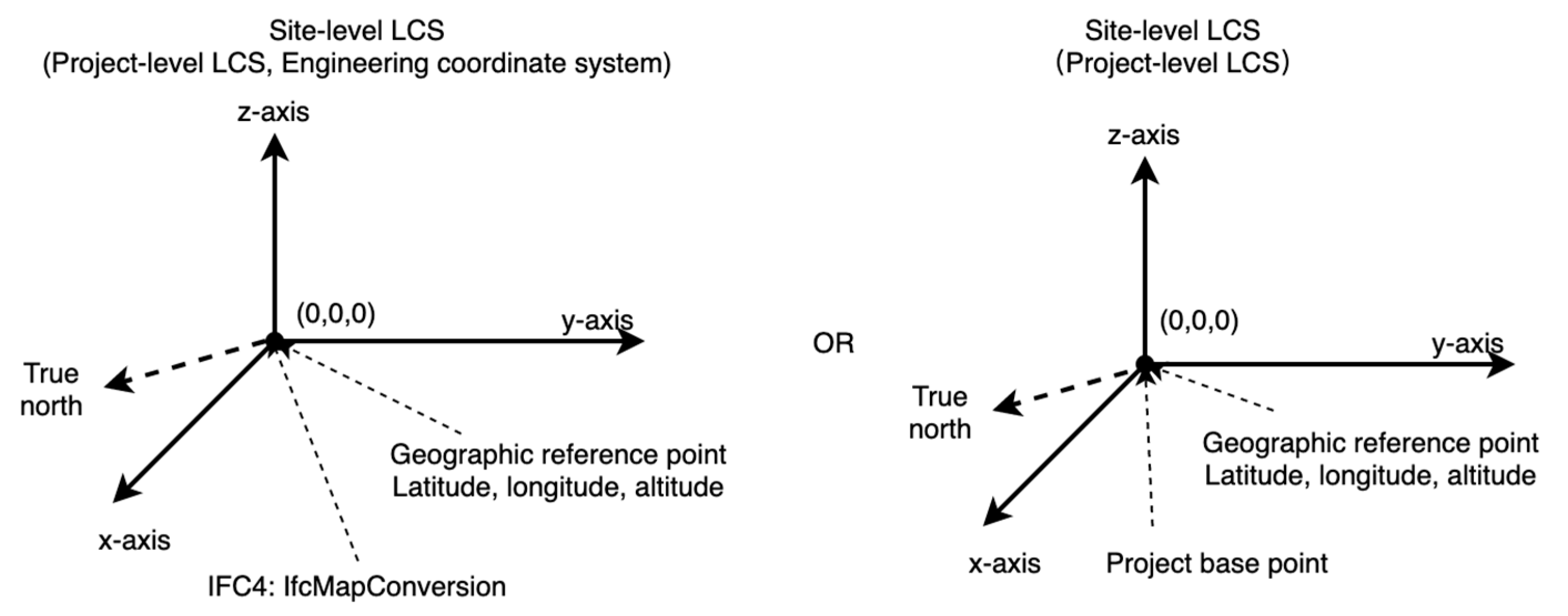


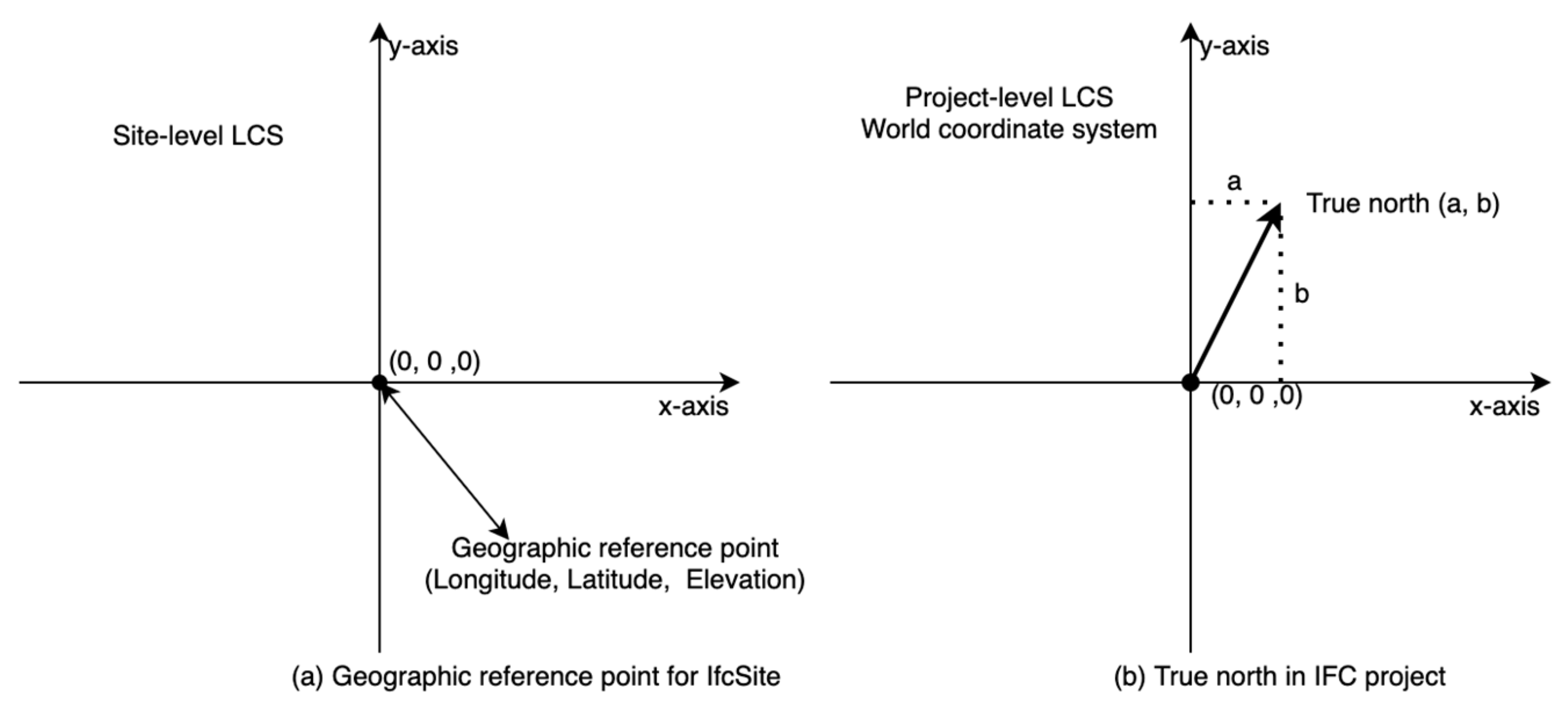
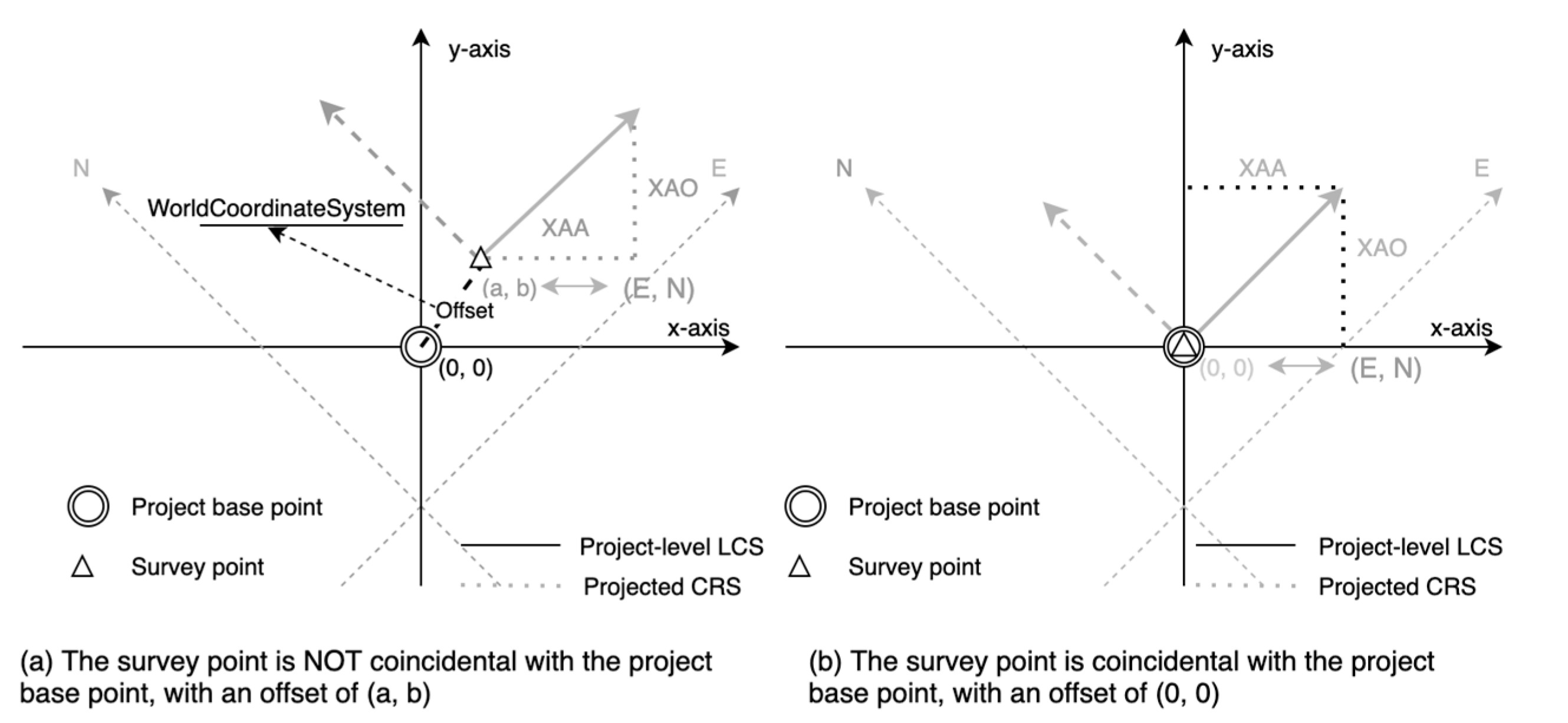

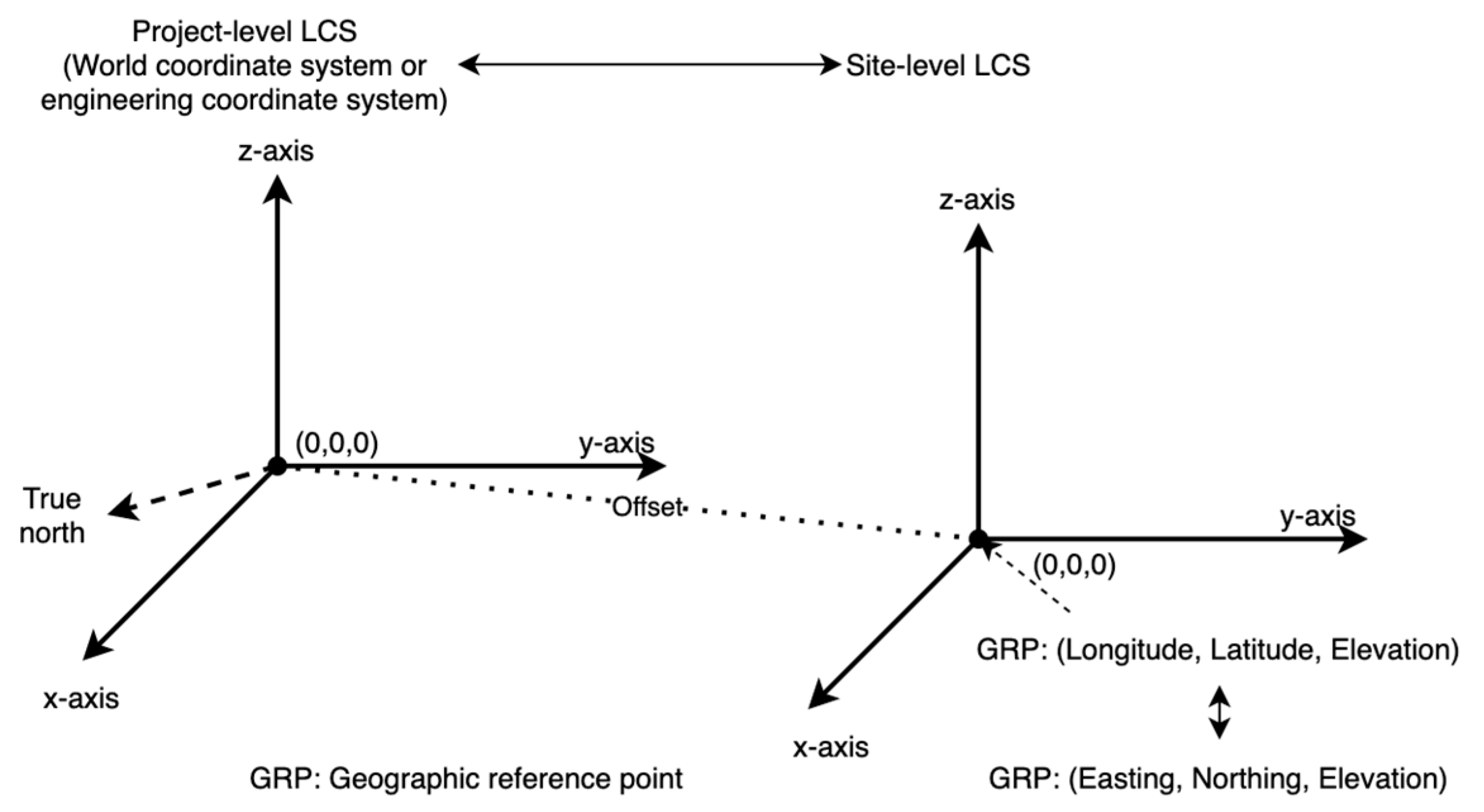
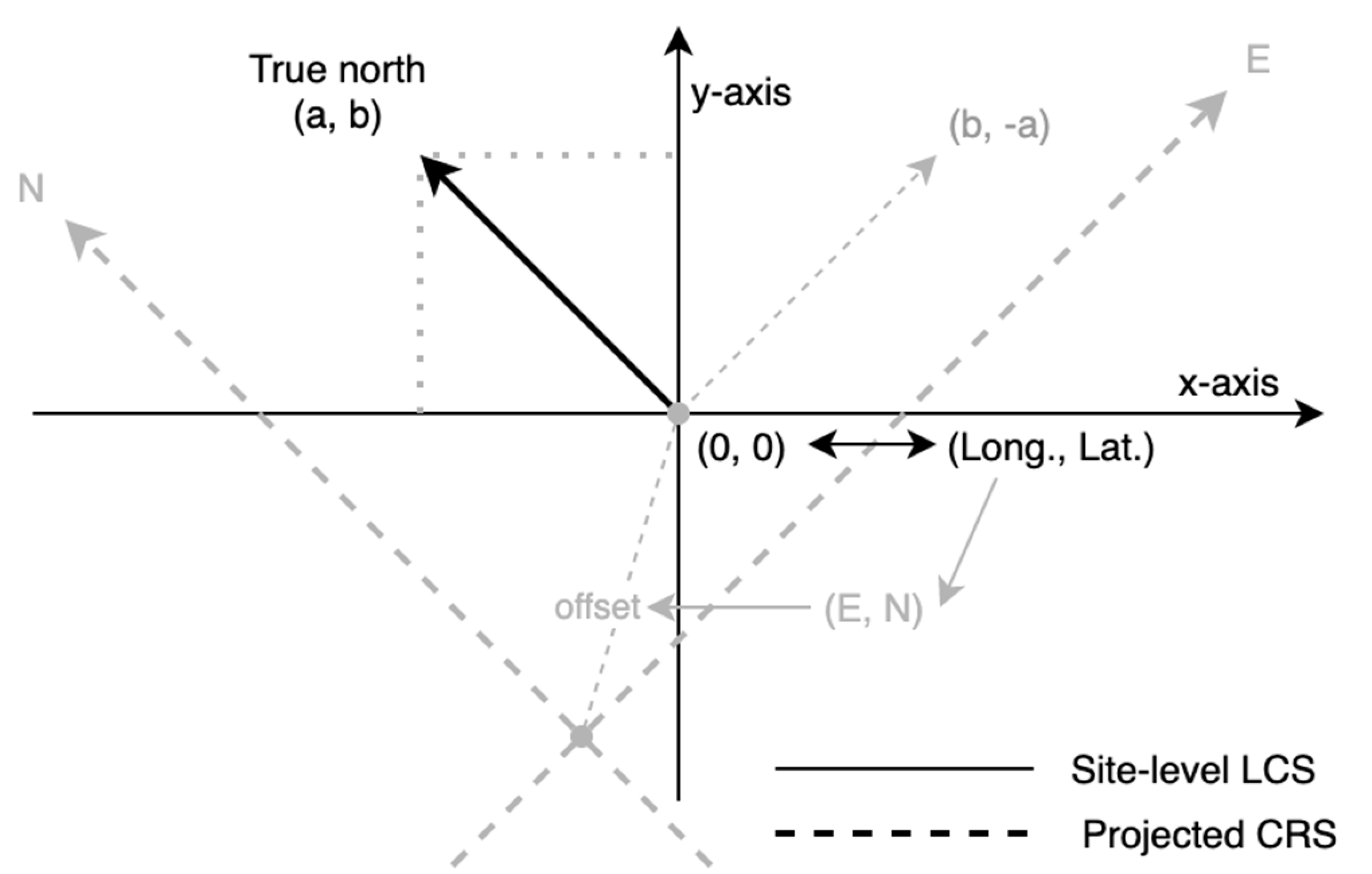





| IFC2x3 TC1 | IFC4 | |
|---|---|---|
| Models with spatial reference | Extending IFC2x3 [22] (suggested) | Using IfcMapConversion [22,23] |
| Models without spatial reference | 1. Manually processing [21,24] 2. Automatically processing using other geo-referenced data [11] | |
| Geo-Ref1 | Geo-Ref2 | |
|---|---|---|
| Starting point | Raw spatial data without spatial reference (non-geo-referenced) | Data with spatial reference (semi-geo-referenced) |
| Focus | Step 1: Establishing spatial reference | Step 2: Coordinate transformation |
| Scope | From non-geo-referenced data to geo-referenced data in CRS | From semi-geo-referenced data to geo-referenced data in geographic CRS |
| Motivation | Spatial data management and analysis in GIS by providing a common coordinate framework | Obtaining accurate geodetic coordinates for construction activities |
| Pros | Cons | |
|---|---|---|
| Arroyo Ohori et al. [21] |
|
|
| Clemen and Hendrik [12] |
|
|
| Uggla et al. [29] |
|
|
| IFC2x3 TC1 | IFC4 ADD2 TC1 | |
|---|---|---|
| World coordinate system (WCS) | Establishment of the engineering coordinate system (often referred to as the world coordinate system in CAD) for all representation contexts used by the project. Usually set to origin: (0, 0, 0) and x-axis (1, 0, 0), y-axis (0, 1, 0), and z-axis (0, 0, 1). | Establishment of the engineering coordinate system (often referred to as the world coordinate system in CAD) for all representation contexts used by the project. Usually set to origin: (0, 0, 0) and x-axis (1, 0, 0), y-axis (0, 1, 0), and z-axis (0, 0, 1). If is defined, then the WCS is used to define the offset (origin shift) between the zero point of the local engineering coordinate system and the geographic reference point to which the offset relates. In preferred practice, both points (also known as “project base point” and “survey point”) should be coincidental. However, it is possible to offset the geographic reference point from the local zero point. |
| Model | Source | Geographic Reference Point | True North | Inspection Result | |
|---|---|---|---|---|---|
| 1 | Institute | IfcWiki | (8.716667, 49.150000, 0.0) | (0, 1) | Incorrect |
| 2 | Smiley | IfcWiki | (8.390980, 49.033244, 110.0) | (−0.53730, −0.84339) | Incorrect |
| 3 | House 1 | IfcWiki | (8.436539, 49.100435, 110.0) | (0.76604, 0.64279) | correct |
| 4 | House 2 | OIMR | Not defined | Not defined | Incorrect |
| 5 | bridge 1 | project | (149.126556, −35.306541, 0.0) | (0, 1) | Incorrect |
| 6 | bridge 2 | project | Not defined | Not defined | Incorrect |
| 7 | T18001_Zonghelou | OIMR | (114.279200, 30.572500, 0.0) | (0, 1) | Incorrect |
| 8 | OTC-Conference-Center | OIMR | (−71.060300, 42.358300, 0.0) | (0, 1) | Incorrect |
| 9 | Rac_advanced_sample_project | OIMR | (−71.46100, 42.991000, 0.0) | (0, 1) | Incorrect |
| 10 | AZUMA9 | OIMR | (135.492263, 34.610618, 1.0) | (0, 1) | Incorrect |
| 11 | Svaleveien_8_Hus_A | OIMR | (0.0, 0.0, not defined) | (0, 1) | Incorrect |
| 12 | Autodesk_Hospital_Parking | OIMR | (−77.615000, 43.168000, 0.0) | (0.99939,0.03490) | Incorrect |
| 13 | Dubal-Herrera-limpio | OIMR | (−71.059776, 42.358429, 0.0) | (0, 1) | Incorrect |
| Original Spatial Reference | Transformation Parameters |
|---|---|
| Latitude (degree): 49.033244 | Origin shift—Northing (meter): 455484.51059 |
| Longitude (degree): 8.390980 | Origin shift—Easting (meter): 5431330.07251 |
| Elevation (meter): 110.0 | Origin shift—Elevation (meter): 110.0 |
| True north: (−0.53730, −0.84339) | Transformation matrix: |
Publisher’s Note: MDPI stays neutral with regard to jurisdictional claims in published maps and institutional affiliations. |
© 2021 by the authors. Licensee MDPI, Basel, Switzerland. This article is an open access article distributed under the terms and conditions of the Creative Commons Attribution (CC BY) license (https://creativecommons.org/licenses/by/4.0/).
Share and Cite
Zhu, J.; Wu, P. A Common Approach to Geo-Referencing Building Models in Industry Foundation Classes for BIM/GIS Integration. ISPRS Int. J. Geo-Inf. 2021, 10, 362. https://0-doi-org.brum.beds.ac.uk/10.3390/ijgi10060362
Zhu J, Wu P. A Common Approach to Geo-Referencing Building Models in Industry Foundation Classes for BIM/GIS Integration. ISPRS International Journal of Geo-Information. 2021; 10(6):362. https://0-doi-org.brum.beds.ac.uk/10.3390/ijgi10060362
Chicago/Turabian StyleZhu, Junxiang, and Peng Wu. 2021. "A Common Approach to Geo-Referencing Building Models in Industry Foundation Classes for BIM/GIS Integration" ISPRS International Journal of Geo-Information 10, no. 6: 362. https://0-doi-org.brum.beds.ac.uk/10.3390/ijgi10060362






